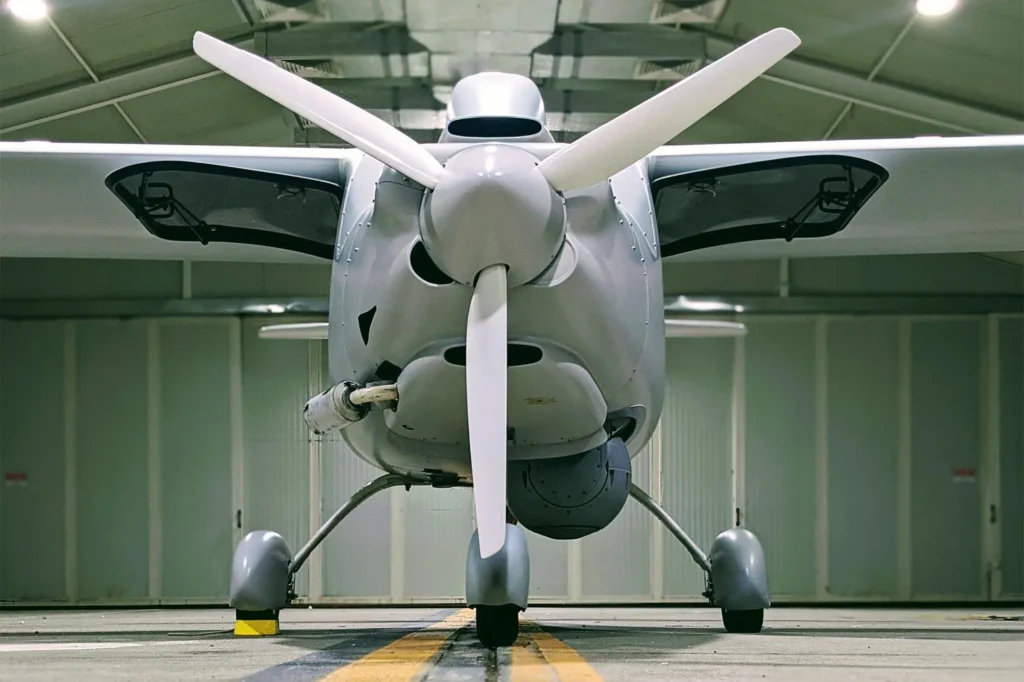SOCOM wants its secretive Long Endurance Aircraft drone to be able to launch smaller drones
- By Frumentarius
Share This Article

According to The War Zone, U.S. Special Operations Command (SOCOM) is set to outfit its secretive, ultra-quiet surveillance drone – known as the Long Endurance Aircraft (LEA), or RQ-29 – with the capability to launch smaller aerial drones while in flight. This planned enhancement of the LEA platform would give the unmanned aircraft the ability not just to perform intelligence, surveillance, and reconnaissance (ISR) missions, but also theoretically to perform strike (attack) missions and illustrates yet again the changing nature of warfare.
SOCOM’s LEA program was shrouded in secrecy and only became known to defense industry watchers in 2021, after one of the aircraft crashed in Irbil, Iraq, in 2020. Technology Service Corporation (TSC), which builds the LEA, describes the platform as an unmanned aircraft providing “highly efficient” ISR capability with “customer selected data collection payloads.” This means that SOCOM specifies the ISR capability it wants and selects the hardware that is deployed on the LEA to provide it.
According to TSC, the LEA can fly up to 17,000 feet and has a nominal operational endurance limit of 24 hours and a maximum endurance of over 30 hours. The LEA is based on a popular civilian powered glider design that is modified for unmanned military use in permissive and semi-permissive environments. This makes it effective as an ISR platform in low-intensity conflict areas such as Syria, Iraq, and Afghanistan, but might limit its effectiveness in a high-end conflict with a country such as China or Russia as the LEA would be susceptible to being shot down by an enemy more capable in anti-aircraft operations than your typical terrorist group.
In its 2026 budget request, SOCOM is seeking to use already allotted 2025 funds to modify the LEA to enable it to launch smaller drones while in flight. These smaller drones – referred to in the budget language as “Air Launched Effects” (ALE) payloads – could then expand the LEA’s surveillance mission, for example, by following a vehicle that leaves a target compound while the LEA remains on site over the original target compound. The smaller launched drones could also theoretically be outfitted with armaments that allow them to act as attack (strike) platforms, thus converting the LEA from an ISR-only platform, to one capable of kinetic strike missions as well.
This planned enhancement of the SOCOM RQ-29 is one small detail in the larger story of the U.S. military’s effort to adapt to the changing nature of warfare.
The war in Ukraine has illustrated for military planners everywhere that unmanned systems – in the air, on land, and on and below the sea – will play a major role in future armed conflicts. Those militaries that are best able to harness this new technology, further develop it, and integrate it into their arsenals and war plans in an effective way, will undoubtedly posses both tactical and strategic advantages in tomorrow’s wars. While we have not yet reached a place in time where drones confront drones on the battlefield, while humans in the background control these platforms with the help of artificial intelligence, we are moving closer to that destination with every passing day.
Read more from Sandboxx News
- White House pauses Navy’s F/A-XX next-gen aircraft. Is this the way forward?
- The U‑2 spy plane just made history again by breaking two more records
- Serbia’s unique Zastava M21 – Service rifles from around the world
- 7 strategies to stay positive in your military (or in any) career
- Big tech is trying to hack shipbuilding for the Navy. Will it succeed?
Related Posts
Sandboxx News Merch
-

‘AirPower’ Classic Hoodie
$46.00 – $48.00Price range: $46.00 through $48.00 Select options This product has multiple variants. The options may be chosen on the product page -

‘Kinetic Diplomacy’ Bumper Sticker (Black)
$8.00 Add to cart -

‘Sandboxx News’ Trucker Cap
$27.00 Select options This product has multiple variants. The options may be chosen on the product page
Frumentarius
Frumentarius is a former Navy SEAL, former CIA officer, and currently a battalion chief in a career fire department in the Midwest.
Related to: Airpower, Special Operations

7 strategies to stay positive in your military (or in any) career

How Navy SEAL candidates recover after Hell Week

First Special Service Force was a unique World War II Americano-Canadian commando unit

Sandboxx News
-

‘Sandboxx News’ Trucker Cap
$27.00 Select options This product has multiple variants. The options may be chosen on the product page -

‘AirPower’ Classic Hoodie
$46.00 – $48.00Price range: $46.00 through $48.00 Select options This product has multiple variants. The options may be chosen on the product page -

‘AirPower’ Golf Rope Hat
$31.00 Select options This product has multiple variants. The options may be chosen on the product page -

‘Sandboxx News’ Dad Hat
$27.00 Select options This product has multiple variants. The options may be chosen on the product page
